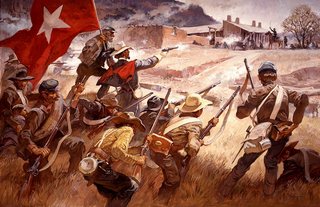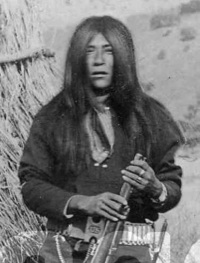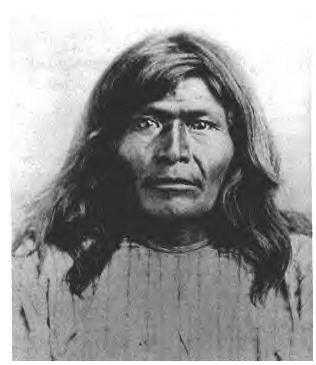
The Arizona Territory, colloquially referred to as Confederate Arizona, was an organized incorporated territory of the Confederate States of America that existed from August 1, 1861, to May 26, 1865, when the Confederate States Army Trans-Mississippi Department, commanded by General Edmund Kirby Smith, surrendered at Shreveport, Louisiana. However, after the Battle of Glorieta Pass, the Confederates had to retreat from the territory, and by July 1862, effective Confederate control of the territory had ended. Delegates to the secession convention had voted in March 1861 to secede from the New Mexico Territory and the Union, and seek to join the Confederacy. It consisted of the portion of the New Mexico Territory south of the 34th parallel, including parts of the modern states of New Mexico and Arizona. The capital was Mesilla, along the southern border. The breakaway region overlapped Arizona Territory, established by the Union government in February 1863.

The Battle of Glorieta Pass was fought March 26–28, 1862 in the northern New Mexico Territory, by Union and Confederate forces during the American Civil War. While not the largest battle of the New Mexico campaign, the Battle of Glorieta Pass ended the Confederacy's efforts to capture the territory and other parts of the western United States.

The Chiricahua Mountains massif is a large mountain range in southeastern Arizona which is part of the Basin and Range province of the west and southwestern United States and northwest Mexico; the range is part of the Coronado National Forest. The highest point, Chiricahua Peak, rises 9,759 feet (2,975 m) above sea level, approximately 6,000 feet (1,800 m) above the surrounding valleys. The range takes its name from the Chiricahua Apaches native to the region.

The Apache Wars were a series of armed conflicts between the United States Army and various Apache tribal confederations fought in the southwest between 1849 and 1886, though minor hostilities continued until as late as 1924. After the Mexican–American War in 1846, the United States annexed conflicted territory from Mexico which was the home of both settlers and Apache tribes. Conflicts continued as American settlers came into traditional Apache lands to raise livestock and crops and to mine minerals.

The Battle of Picacho Pass, also known as the Battle of Picacho Peak, was an engagement of the American Civil War on April 15, 1862. The action occurred around Picacho Peak, 50 miles (80 km) northwest of Tucson, Arizona. It was fought between a Union cavalry patrol from California and a party of Confederate pickets from Tucson, and marks the westernmost battle of the American Civil War involving fatalities.

Massai was a member of the Mimbres/Mimbreños local group of the Chihenne band of the Chiricahua Apache. He was a warrior who was captured but escaped from a train that was sending the scouts and renegades to Florida to be held with Geronimo and Chihuahua.

The 1st Cavalry Regiment is a United States Army regiment that has its antecedents in the early 19th century in the formation of the United States Regiment of Dragoons. To this day, the unit's special designation is "First Regiment of Dragoons". While they were the First Regiment of Dragoons, another unit designated the 1st Cavalry Regiment was formed in 1855 and in 1861 was re-designated the 4th Cavalry Regiment. The First Dragoons became the 1st Cavalry Regiment, since they were the oldest mounted regiment.

The First Battle of Dragoon Springs was a minor skirmish between a small troop of Confederate dragoons of Governor John R. Baylor's Arizona Rangers, and a band of Apache warriors during the American Civil War. It was fought on May 5, 1862, near the present-day town of Benson, Arizona, in Confederate Arizona.

The Battle of the Mimbres River was a surprise attack launched by a troop of American militia against an encampment of Chiricahua Apaches along the western shore of the Mimbres River.
The Battle of Cookes Canyon was a military engagement fought between settlers from Confederate Arizona and Chiricahua Apaches in August 1861. It occurred about 40 miles (64 km) northwest of Mesilla, in Cookes Canyon. The exact date of the battle is unknown. The battle occurred in the larger context of both the Apache Wars and the American Civil War.
The Battle of the Florida Mountains was an action of the Apache Wars. Forces involved were Chiricahua Apache warriors and mounted Confederate States militia. The battle occurred in a pass of the Florida Mountains within Confederate Arizona, now southwestern New Mexico. The engagement occurred sometime around the middle of August 1861.
The Battle of Pinos Altos was a military action of the Apache Wars. It was fought on September 27, 1861, between settlers of Pinos Altos mining town, the Confederate Arizona Guards, and Apache warriors. The town is located about seven miles north of the present day Silver City, New Mexico.

The Second Battle of Dragoon Springs was one of two skirmishes involving Apache warriors and Confederate soldiers in Arizona. It was fought during the American Civil War on May 9, 1862, and was a response to the First Battle of Dragoon Springs in which Confederate forces were defeated. Four men were killed in the first skirmish and several heads of livestock were captured. The rebel commander Captain Sherod Hunter, ordered his foraging squad to take back the livestock from Cochise's warriors, during which five Apaches were killed. There were no Confederate casualties.

Presidio San Agustín del Tucsón was a presidio located within Tucson, Arizona, United States. The original fortress was built by Spanish soldiers during the 18th century and was the founding structure of what became the city of Tucson. After the American arrival in 1846, the original walls were dismantled, with the last section torn down in 1918. A reconstruction of the northeast corner of the fort was completed in 2007 following an archaeological excavation that located the fort's northeast tower.

The Battle of Fort Buchanan was an Apache attack on the United States Army post of Old Fort Buchanan in southern Arizona Territory, which occurred on February 17, 1865. Though a skirmish, it ended with a significant Apache victory when they forced the small garrison of California Volunteers to retreat to the Santa Rita Mountains. Fort Buchanan was the only American military post conquered during the war against the Chiricahua.
The Battle of Cookes Spring was a skirmish which took place between Apache raiders and the United States Army on March 9, 1857. Apache raiders were tracked through the frontier by a party of U.S. Army cavalry who intercepted the native warriors at Cooke's Spring in the Black Range of New Mexico.

The Bonneville Expedition was a military operation launched by the United States Army in 1857 at the beginning of the Chiricahua Apache Wars. Colonel Benjamin Bonneville, Lieutenant Colonel Dixon S. Miles, and Colonel William W. Loring commanded parties which headed west from Fort Fillmore, New Mexico Territory. The expedition quickly engaged Apaches in two small but significant battles, the first in the Black Range and the second along the Gila River near present-day Safford, Arizona.

Victorio's War, or the Victorio Campaign, was an armed conflict between the Apache followers of Chief Victorio, the United States, and Mexico beginning in September 1879. Faced with arrest and forcible relocation from his homeland in New Mexico to San Carlos Indian Reservation in southeastern Arizona, Victorio led a guerrilla war across southern New Mexico, west Texas and northern Mexico. Victorio fought many battles and skirmishes with the United States Army and raided several settlements until the Mexican Army killed him and most of his warriors in October 1880 in the Battle of Tres Castillos. After Victorio's death, his lieutenant Nana led a raid in 1881.

The raid on Bear Valley was an armed conflict that occurred in 1886 during Geronimo's War. In late April, a band of Chiricahua Apaches attacked settlements in Santa Cruz County, Arizona over the course of two days. The Apaches raided four cattle ranches in or around Bear Valley, leaving four settlers dead, including a woman and her baby. They also captured a young girl, who was found dead several days after the event, and stole or destroyed a large amount of private property. When the United States Army learned of the attack, an expedition was launched to pursue the hostiles. In May, two small skirmishes were fought just across the international border in Sonora, Mexico but both times the Apaches were able to escape capture.
The Battle of Devil's Creek was a military engagement during Geronimo's War, fought on May 22, 1885 near Alma, New Mexico. Though it was a minor skirmish, it was the first battle of the Geronimo campaign and ended after the Apaches were routed from their positions.















